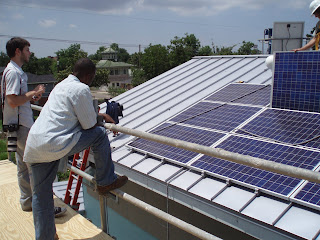
The Earthship design was first developed in Taos, New Mexico by sustainability guru Michael Reynolds. Incorporating the use of society’s throw-away products like tires, glass bottles, plastic containers and aluminum cans, Earthships were built using minimal amounts of cement, treated wood, plaster and other common construction materials. Modern Earthship designs are self-sustainable, off-grid structures that utilize water catchment systems, solar panels, thermal heating and cooling, contained sewage treatment and internal food harvesting systems.
For native Nicaraguans, life is relatively simple. Much of the population already live off-grid due to several factors including an unwillingness by power supply companies to run power lines into the isolated, rural areas where many locals live and work. In contrast to the cost of living in Nicaragua, energy is also extremely expensive and for those who do live in on-grid areas, there are frequent power outages that can last for hours. It is arguably more practical to develop everyday habits that don’t require electricity use, or, to live in an Earthship.

When Tim Kelly, a transplanted Californian real-estate developer among many ex-pats in San Juan del Sur that have recently flocked to Nicaragua’s southern Pacific coast, bought 550 acres of land on the side of a mountain on the edge of town, he wasn’t planning to host Nicaragua’s first Earthship. When his friend David Kniffin, a long time green building enthusiast who had done an internship with Michael Reynolds’ company Earthship Biotecture, jokingly declared he wanted to build one on a flat, lower-laying plot on Kelly’s parcel, the Casa Llanta project was born.
“Mike [Reynolds] likes the idea of going to new places, he liked the fact that we were actually totally off-grid and that we were going to be utilizing land that didn’t have power and didn’t have easy water access. Why build all these power poles and drag all these millions of miles of wire, digging wells and pumping water? Just build an Earthship,” said Kelly.

In December of 2007, a crew of ten Taos-trained Earthship builders arrived in Nicaragua to join 13 local laborers who broke ground on Casa Llanta. The hybrid construction crew got right down to work; collecting materials from nearby transportation hub Rivas, packing dirt into tires to be laid as “bricks” forming load-bearing walls, and cutting and cleaning plastic and glass bottles for honeycomb-style light bearing cut-outs.
The 1800 square foot Earthship was completed in August 2009. Finished, the back is built into the Earth for maximum natural heating and cooling for comfort in any climate making it appropriate and adaptable with the extreme conditions of the country’s rainy and dry seasons. The three-dome water catchment system is designed to maximize use of available rain water through a series of filtration methods including garden filters, leveraging what falls from the sky for use in showers, toilets and to water plants. Excess rain accumulated during the rainy season is stored in cisterns for use during the dry, desert-like months. The roof of Casa Llanta dons five 123-watt solar panels which collect energy from the sun for as much as eight hours of daylight; enough to power the refrigerator, lights and to recharge laptops. Casa Llanta is immune from two of the major challenges of Nica-living; frequent power outages and crop-crippling precipitation shortages.

Casa Llanta is situated among a community that is home to a few hundred Nicaraguan families, according to Brooke Rundle, San Juan del Sur real estate agent and founding member of the Earthship crew. Along with the indigenous population, the area has seen significant growth during the last ten years as an influx of international developers have discovered acres of undisturbed land ripe with oceanfront property, quiet beach views and access, and mountain look-out lots. As neighboring Costa Rica has struggled with the preservation of distinctive Tico-culture in the face of a similar foreign-investor development boom, Nicaragua now faces a similar challenge.

“We’re trying to make this a community effort and not just another case of gringos who are coming down and building just like everyone else. We’re really focused on helping the community thrive, and helping to get more and more of both the local and visiting people involved,” said Rundle.
The process of building the Earthship has provided benefits to the local community that the projects leaders hope will lead to sustained results. Working alongside the Taos-trained Earthship crew members, local laborers from the surrounding area learned to utilize cheap, locally abundant materials to build spaces that are conducive to solving some of the contemporary challenges of Nicaraguan living.
Natural heating and cooling through passive solar and thermal mass, water catchment with simple rooftop collection systems and sustainable agriculture are also among the Earthship’s simply executed and affordable solutions to both extreme rains and debilitating dry seasons.

“We’re trying to figure out building methods that are less costly and more feasible for the locals to use. For example, the local school runs out of water every single year during the dry season. It’s pretty easy to install a simple water catchment system off the roof. If [local residents] need a retaining wall in their homes, why not build it out of tires? Tires are free and there are a lot right outside of town. There’s actually a ton, because the roads are so bad here,” said Rundle.
The ambitious Earthship crew is optimistic for the future development of the Casa Llanta community. Committed to staying off-grid, Tim Kelly sells exclusively to those who accept that the lots will not have access to fossil-fueled utilities to ensure strictly solar, wind and renewable energy use. He believes the Earthship, which sits on the lowest piece of the 550-acre package, will be instrumental in illustrating the benefits and feasibility of both the Earthship design and the off-grid option in general.
















